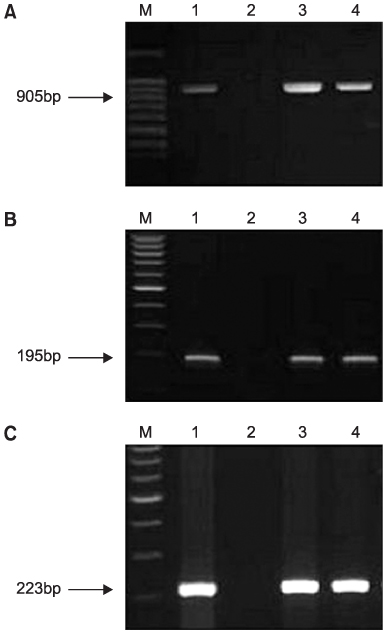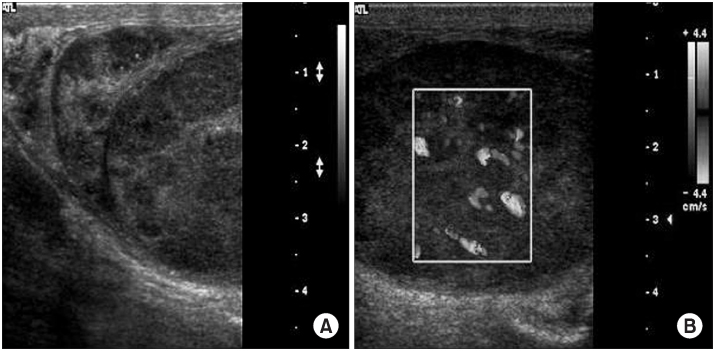Korean J Urol.
2007 Mar;48(3):359-362. 10.4111/kju.2007.48.3.359.
Brucella Epididymorchitis: A Rare Cause of Testicular Mass
- Affiliations
-
- 1Department of Urology, College of Medicine, Dongguk University, Gyeongju, Korea. ksleemd@dongguk.ac.kr
- 2Department of Diagnostic Radiology, College of Medicine, Dongguk University, Gyeongju, Korea.
- 3Department of Laboratory medicine, College of Medicine, Dongguk University, Gyeongju, Korea.
- 4Division of Zoonoses, Center for Immunology & Pathology, KNIH, Seoul, Korea.
- KMID: 1997139
- DOI: http://doi.org/10.4111/kju.2007.48.3.359
Abstract
- Brucellosis is a zoonosis, which is caused by Brucella abortus, B. melitensis, B. suis and B. canis. Brucellosis has been an emerging disease since the discovery of B. melitensis, by Bruce, in 1887. Worldwide, brucellosis remains a major source of disease in both humans and domesticated animals. A high prevalence in certain geographical areas is well recognized, but has been largely underestimated. In Korea, the first human case of Brucellosis occurred in 2002, but the incidence of human brucellosis has now increased. Herein, a case of epididymorchitis due to brucellosis is reported.
Keyword
MeSH Terms
Figure
Reference
-
1. Korea centers for disease control and prevention. 2005 Communicable disease surveillance year book. 2005. 62.2. Park MY, Lee CS, Choi YS, Park SJ, Lee JS, Lee HB. A sporadic outbreak of human brucellosis in Korea. Korean J Med Sci. 2005. 20:941–946.3. De Massis F, Di Girolamo A, Petrini A, Pizzigallo E, Giovannini A. Correlation between animal and human brucellosis in Italy during the period 1997-2002. Clin Microbiol Infect. 2005. 11:632–636.4. Young EJ. Mandell GL, Douglas RG, Bennett JE, Dolin R, editors. Brucella species. Mandell, Douglas and Bennett's principles and practice of infectious diseases. 2005. 6th ed. Philadelphia: Churchill Livingstone;2669–2674.5. Kadikoylu G, Tuncer G, Bolaman Z, Sina M. Brucellar orchitis in Innerwest Anatolia Region of Turkey. A report of 12 cases. Urol Int. 2002. 69:33–35.6. Navarro-Martinez A, Solera J, Corredoira J, Beato JL, Martinez-Alfaro E, Atienzar M, et al. Epididymoorchitis due to Brucella mellitensis: a retrospective study of 59 patients. Clin Infect Dis. 2001. 33:2017–2022.7. Khan MS, Humayoon MS, Al Manee MS. Epididymo-orchitis and brucellosis. BJU Int. 1989. 63:87–89.8. Osegbe DN. Testicular function after unilateral bacterial epididymo-orchitis. Eur Urol. 1991. 19:204–208.9. Ingerslev HJ, Walter S, Andersen JT, Brandenhoff P, Eldrup J, Geerdsen JP, et al. A prospective study of antisperm antibody development in acute epididymitis. J Urol. 1986. 136:162–164.10. Memish ZA, Venkatesh S. Brucellar epididymo-orchitis in Saudi Arabia: a retrospective study of 26 cases and review of the literature. BJU Int. 2001. 88:72–76.
- Full Text Links
- Actions
-
Cited
- CITED
-
- Close
- Share
- Similar articles
-
- A Case of Antenatal Testicular Torsion Mimicking Inflammation and Tumor in the Neonate
- Successful Medical Treatment of Prosthetic Mitral Valve Endocarditis Caused by Brucella abortus
- A Case of Leydig Cell Tumor of Testis in Child
- Solitary Testicular Metastasis of Prostate Cancer Mimicking Primary Testicular Cancer
- A Case of Fibrous Pseudotumor of Testicular Tunic



